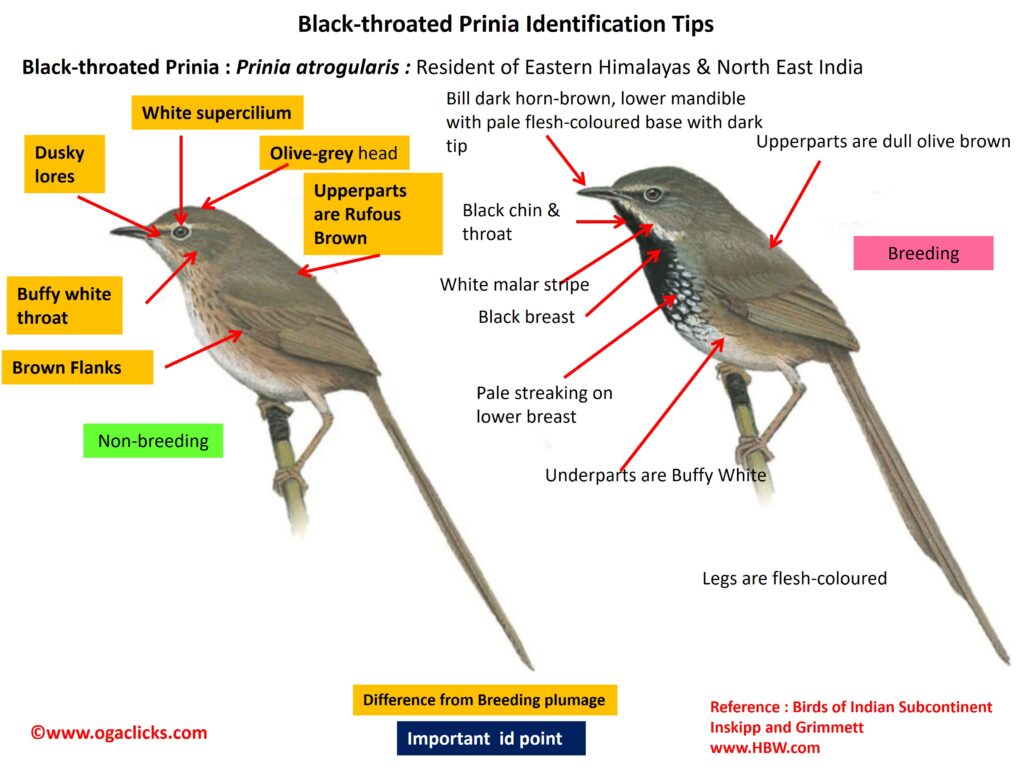
Black-throated Prinia Prinia atrogularis
Etymology:
- Prinia : Javanese name Prinya for the Prinia
- Atrogularis: Latin word Atro – Dark, Gularis – Throat
Vernacular Name: Pahari: Chiburchay, Cachar: Daotisha dedao, Bhutan: Shikshillik
Distribution : Resident of Eastern Himalayas & Nort East Indian Hills.
Description : It has a size of 14–16 cm; 8–16 g. It is a large prinia with r slender, slightly decurved bill and very long graduated, pointed tail. The nominate race in fresh plumage (non-breeding) has dull face weakly patterned by dusky lores, bordered above by short whitish supercilium which diffuses behind eye. Rest of head and nape are olive-grey, merging into rufous-brown on mantle, wings, scapulars, rump and uppertail-coverts, The flight-feathers have brighter rufous fringes. The tail is plain rufous; throat and underparts are buffy white, becoming almost brown on lower flanks and undertail-coverts. There is a variable amount of black streaking or broken scaling on breast side The iris is pale brown to grey-brown; bill is dark horn-brown, lower mandible has pale flesh-coloured base becoming darker at tip. The legs are flesh-coloured to fleshy brown. In breeding plumage (acquired through feather wear) entire upperparts become dull olive-brown, lacking rufous tones (some rufous usually evident on wings); whitish supercilium disappears with wear, but throat and breast become almost solidly blackish, broken by whitish malar line and invaded by pale streaking on lower breast; longest tail feathers often frayed and broken. Both the sexes are similar in plumage. The male is distinctly larger and relatively longer-tailed than female. The juvenile is similar to fresh-plumaged adult, but is paler brown above, washed light yellow below, with olive-grey breastband and tail is shorter.
Habitat: It is found in open grassy hillsides and mountainsides with scrubby cover and scattered shrubs; scrubby forest clearings and bracken-covered hillsides, as well as rank vegetation by edges of villages, open pine forest, and terraced cultivation. It is found in summer between 900 m and 2565 m, in winter reported down to 600 m – 2200 m.
Food habits: It eats insects and their larvae. It is normally encountered singly or in pairs, and usually very skulking, but forages also in noisy family parties. It feeds low down among grassy or tangled vegetation. It is hyperactive, with tail twitched up and down and even vibrated from time to time as it works its way through clumps of vegetation. If suddenly flushed, flies low and hesitantly for short distance before diving back into cover.
Breeding habits: They breed in Mar–Jun. The territories are well spaced. The nest built by both sexes, a globular construction with large side entrance, made of various grasses and flowering grass heads, mixed with small amounts of moss, usually well hidden in grassy clump, loosely attached to two or three grass stems. They lay a clutch of 3–5 eggs, The incubation is shared by both sexes for a period of 10 days. Both parents also tend nestlings